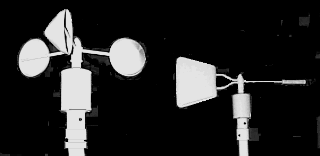|
E. Linacre and B. Geerts |
4/'99 |
![]()

A question that arises in aviation safety is what accuracy of surface wind measurement is needed for informing pilots of conditions during their take-off or landing? Aircraft lift (for take-off), deceleration (for landing) and overall stability is best when the plane flies into the wind. Costly time may be lost at busy airports when a wind shift mandates a rotation of terminal operations. The accuracy of surface wind measurement depends on:
The last implies distances of about 60 m vertically and 2 km horizontally. Gusts tend not to persist over distances greater than 100 m or so. The result of these considerations is that wind speeds should be averaged over more than 2 minutes, and gusts for more than 5 seconds.
More than one anemometer may be required if conditions are affected by thunderstorms, nearby mountains or a sea breeze. In particular, microbursts can cause sudden local changes in surface wind direction. Large airports which have experienced microbursts now have anemometers at the ends of all runways and in the airport vicinity, and some use a short-wavelength Doppler weather radar.
Reference
(1) Wieringa, J. 1980. Representativeness of wind observations at airports. Bull. Amer. Meteor. Soc. 61, 962-71.